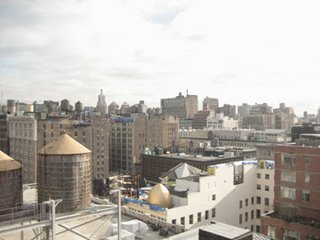Earlier in the week I was with Cara up on the roof of her office location on 22nd and 6th. I took a fair amount of shots that day and as a series of images what I posted was by far the most interesting since it didn’t have to include her building’s house-sized air condition unit that was prone to be in almost any other image.
Interestingly enough, while reading the paper this morning I came across this article in The New York Times about a new condo project involving a historical building, and the developers efforts to restore some of the façade that had originally been removed in the early part of the 20th century. The article primarily focused on the large fiberglass domes that were to be installed on the corners of the building.
When we were on the roof that day I remembered seeing and photographing one of these (middle of photo towards the bottom) wondering what the purpose was in a city that seemed to put a premium on space, since it didn’t seem to have any practical use. And it doesn’t. And that’s a good thing.
That the The New York Times prints about one article like this a week is a testimony to the importance of New York’s history to the city culture. Like many cities, historical structures are at risk here, it’s just the size and the scope of the city often obscure just how much has been leveled for new construction. It was a fine thing to read about a developer willing to go the extra mile on a project like this. It’ll only increase the value of the condos and bring some added flash to the Chelsea neighborhood.
Interestingly enough, while reading the paper this morning I came across this article in The New York Times about a new condo project involving a historical building, and the developers efforts to restore some of the façade that had originally been removed in the early part of the 20th century. The article primarily focused on the large fiberglass domes that were to be installed on the corners of the building.
When we were on the roof that day I remembered seeing and photographing one of these (middle of photo towards the bottom) wondering what the purpose was in a city that seemed to put a premium on space, since it didn’t seem to have any practical use. And it doesn’t. And that’s a good thing.
That the The New York Times prints about one article like this a week is a testimony to the importance of New York’s history to the city culture. Like many cities, historical structures are at risk here, it’s just the size and the scope of the city often obscure just how much has been leveled for new construction. It was a fine thing to read about a developer willing to go the extra mile on a project like this. It’ll only increase the value of the condos and bring some added flash to the Chelsea neighborhood.


